8 Types of Passion Fruit With Wild Tropical Flavors
Author: Anne Cowart | Editor: Omar Alonso
Review & Research: Jen Worst & Chris Miller
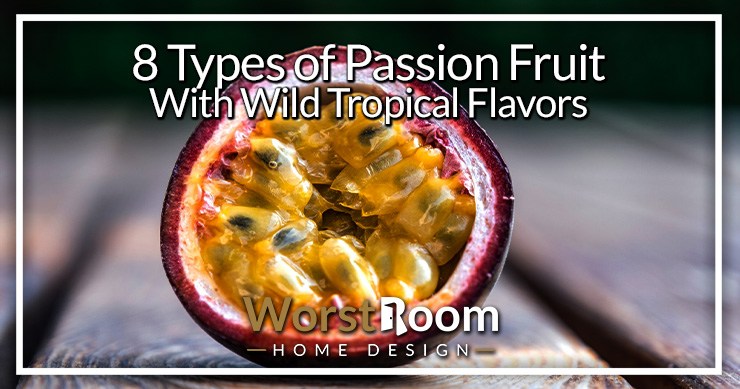
If you are a connoisseur of fruits, then you've probably heard about the sweet and tart flavorful harvest known as the passion fruit. It's an edible product that can be homegrown though is mostly found in local supermarkets. Here we'll guide you through the different types of passion fruit so you can experience the full gamut of options.
Both the flesh and seeds of this fruit are consumable. Homegrown passion fruits are on the sweet end, whereas market ones tend to be sour. Native to Northern Argentina and Southern Brazil, passion fruit has been cultivated and produced in wide varieties. Let's look at those now.
8 Types of Passion Fruit
A fruit that got popular day by day because of its unique tart and sweet flavoring. Passion fruit has been a go-to item for many fresh fruit lovers. When it comes to commercial production, there are four main varieties that you find most commonly, yellow and purple passion fruit, along with two others.
The first four are the main categories, then there are also a few other sub-species or variants that you might not know about that you should if you're a real connoisseur. Check out the list below.
Yellow Passion Fruit
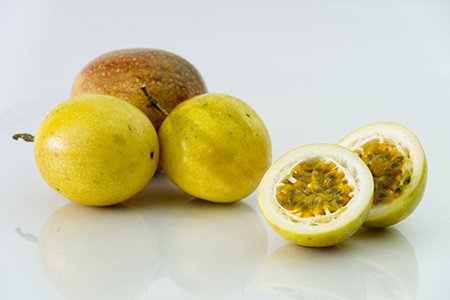
With a thicker and stronger vine, yellow passion fruits are comparatively larger than purple fruits. It belongs to the species called "Passiflora edulis f. flavicarpa Deg.". Some people call it the golden passion fruit because of its yellow to a golden hue.
Yellow passion fruit types come in many categories, and one such is Maracuya, which has a deep yellow color and a bigger shape. Talking about its flavor, when eaten, you will enjoy a tart and sweet flavor at the same time. This fruit has a gelatinous pulp with edible seeds.
You can use the yellow passion fruit seeds on fruit salads or fruit desserts. The juicy yellow bits can also be used as toppings on ice creams and yogurts.
The taste of golden or yellow passion fruit is on the sweet end but will also have some tropical and acidic touch to it. To know what to expect, think about some of the types of peaches with more acidic attributes to them. This variant grows vigorously and also consists of striking flowers to go with the fruits.
Purple Passion Fruits
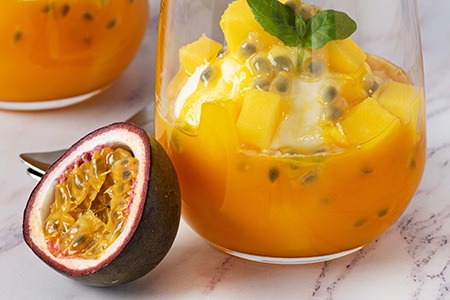
This is a fruit that is round in shape and has curved sides. It starts with green color, and with time, it turns purple when it's ready to be consumed. The fruits are comparatively smaller than the yellow version of it. Purple passion fruit is one of the common variants out there and is full of vitamins.
These types of passion fruit consists of many kinds of vitamin B and vitamin C. When this fruit matures, it tends to get darker in color, and some appear with wrinkles and dents. This fruit is known to have a floral scent.
The common version of purple passion fruit is native to Hawaii and tends to have tougher skin. When opened, you are likely to find black edible seeds that are covered with a yellowish sack of flesh.
Compared to the yellow version, purple fruit is less acidic and substantially juicier. This is the main reason purple passion fruit is a crowd favorite. You'll recognize it scientifically by the name Passiflora edulis Sims".
Giant Passion Fruit
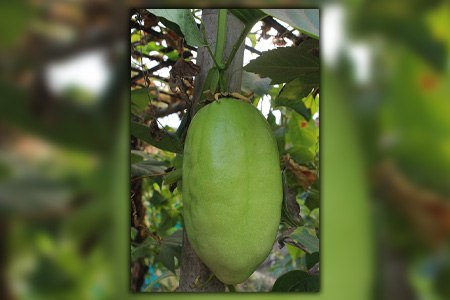
Belonging to the Passifloraceae family, this is also known as Barbadine or giant granadilla in different areas. It's scientifically termed "Passiflora quadrangularis L." This passion fruit does resemble its name and grows large fruits that can be 12 inches in diameter. The only drawback is that it grows pretty slowly, but when it comes to life, you will be surprised by its giant size.
This passion fruit type originated in the North American region, but now it has been adapted to grow in the Hawaii tropical zone. It has a mild acidic taste and packs a punch in terms of juiciness. It contains pulp that is tasty and sweet, with seeds that are slimy yet consumable.
When matured, the skin on giant passion fruit tends to get yellowish. Talking about bigger passion fruit, you won't get anything bigger than this giant version. This fruit is used for making juices, and sometimes they are used to make medicines.
Sweet Passion Fruit
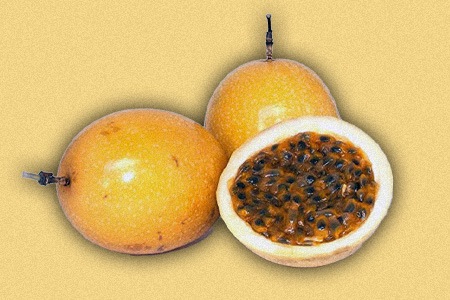
Just like the name suggests, these varieties of passion fruit boast a sweet flavor that has been a crowd pleaser. This is also known as Granadilla, belonging to the passiflora Ligularis family. It is very flavorful, and some even believe that sweet passion fruits are tastier than other passion fruit variants. A decent substitute for sweet passion fruit are any types of papaya with a sweet flavor profile.
This fruit grows blue and later turns orange after it matures. The outer skin is edible, as well as the inside parts. When opened, you will see a white portion that is in between the rind and the flesh. It is edible but is on the bitter end.
The inside flesh comes with a strong tropical aroma, and you will surely enjoy the sweet notes when you bite it. This is the least bitter fruit out there. As for the appearance, it comes in orangish outer flesh. The sweet passion fruit plant boasts purple and white flowers that you can't miss with naked eyes.
Maracuya
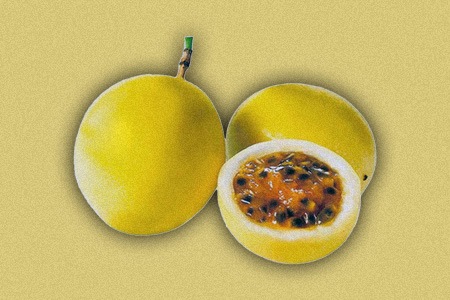
It is the Spanish word for passion fruit. Maracuya is grown in the South American region like Brazil and CostaRica and falls into the subcategory of the yellow passion fruit. In comparison to the orthodox yellow version, this one has a more oblong shape and boasts large fruits.
Well, don't expect it to hit the size of giant passion fruit. Maracuya generally starts with textured skin that eventually smoothens up when they mature. This passion fruit has a distinctive floral aroma and tropical vibe to it. The taste is something to die for, a little tangy mixed with the perfect sweetness.
These types of passion fruit contains adequate potassium, Vitamin C and Vitamin A and also has traces of riboflavin, thiamine, and niacin. Maracuya passion fruits are available throughout the summer and winter seasons. Any types of guava make good substitutes for maracuya and other passion fruit if needed in the kitchen.
Granadilla
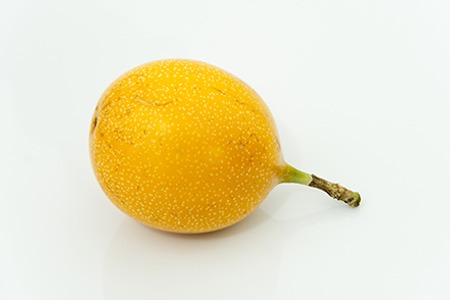
Talking about subspecies of purple passion fruits, granadilla is one such inclusion. This fruit grows small fruit that can turn out to be medium-sized at maximum. These passion fruit varieties never get big, so if you are looking for colossal passion fruit, try out the giant one we mentioned above.
Granadilla has a very thick outer skin that comes in green color. As time progresses, you can expect the rind to change color and turn orangish when they ripen. When it comes to taste, granadilla has tangy, sweet, and fruity notes with floral fragrance.
The seeds that come with it add a little nutty flavor to it. You should eat granadilla when it is fresh and consume it raw to enjoy the overall flavor. These fruits are available from summer through fall. If you have trouble finding it, look under it's scientific name "Passiflora ligularis".
Banana Passion Fruit
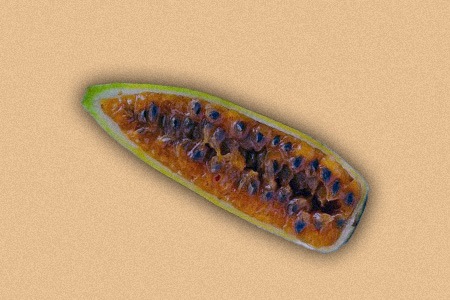
The South American passion fruit variety called Banana Passion is also known as Curuba. This passion fruit has an elongated shape that can reach a length of 12 cm. It grows on long vines that have green leaves on them.
Banana passion fruit is known to have a leathery texture on the surface. It starts with green in the early days and slowly transforms to yellow to orange color as it matures.
Just like the name points out, you might get a hint of banana flavor from this fruit. This passion fruit is extremely juicy and has edible black seeds as well.
This variant can be used to make passion fruit juices and also be used in cocktails, fruit salads, and other tropical recipes.
Misty Gem Passion Fruit
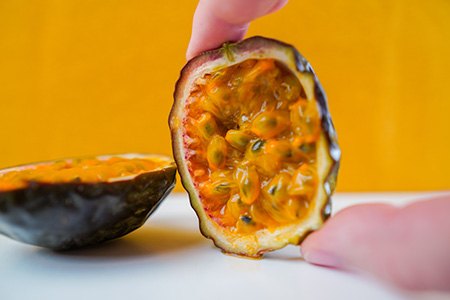
The misty gem variety of passion fruit is a subcategory of the Purple passion fruit. It has a wide range of flavor profiles. Therefore, it is one of the most available types that you can purchase from the market.
Misty gem is not restricted to a region. It can be found in almost every country and is quite popular amongst fruit lovers. As it belongs to the purple group, you can already guess the color profile. It is dark purple on the outside with yellow-orange pulp on the inside.
It also has several black seeds embedded in it. All the parts are consumable and taste sweet, and sometimes, you can also get a hint of tanginess that can remind you of guava. Many people consider this passion fruit the most palatable among other categories.
Types of Passion Fruit for Tart, Sweet, & Sour Options
People who are native to South America love the addition of passion fruit to their tropical fruit baskets. It is a fruit that has a wide range of flavor profiles. You can't enjoy tartness as well as sweetness from its delectable flesh.
The adventure goes much deeper. From selecting the right fruit, slicing it, how much to use in the kitchen, preparing it, serving it, and storing it, there's much to learn about using passion fruit in the kitchen.
One common category is the purple passion fruit. It has a striking color profile and exquisite taste. Not just that, yellow passion fruits are also widely used for their sweetness and the ability to fit into recipes such as salads, cocktails, and much more.
Let us assure you that passion fruit is not limited to Latin America; rather, it is widely available and has been continuously grown by farmers. Surprisingly there are many different types of passion fruit out there for you to become familiar with.




